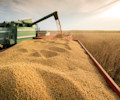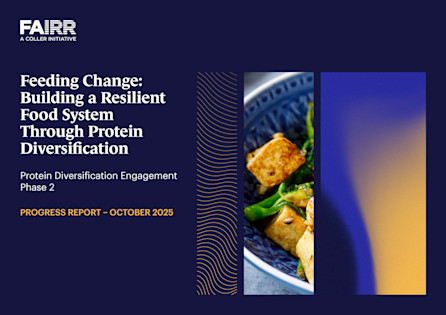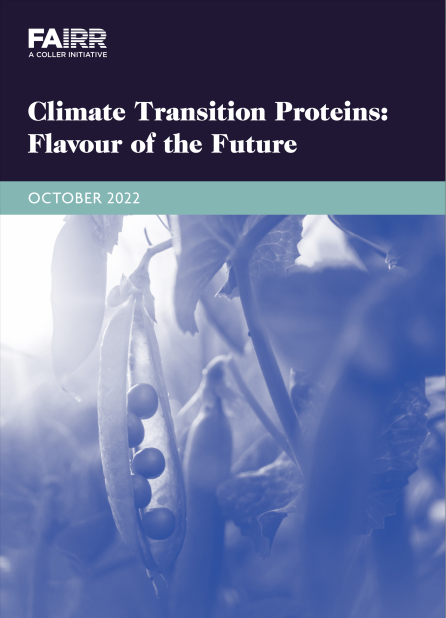Alternative protein sources enable companies to diversify their protein portfolios and reduce the material risks associated with high animal protein exposure, as well as providing them with market opportunities, as this article explores.
Why alternative protein sources matter?
Overall, animal agriculture is responsible for up to 19.6% of global greenhouse gas emissions, while beef production accounts for 41% of global deforestation. Dietary choices are key indicators of environmental sustainability and human health, with high consumption of animal-sourced foods, particularly red and processed meats in Western diets, strongly associated with non-communicable diseases.
Diversifying protein sources can increase supply chain resilience for companies facing financially material climate, nature, public health and regulatory risks, therefore reducing the likelihood of operational disruption and financial losses. According to the Coller FAIRR Climate Risk Tool, under a business-as-usual scenario, impacts related to climate change, such as yield decline in animal feed, increased heat stress of livestock and water scarcity, could result in losses of US$1.3 trillion by 2030 for 40 of the largest livestock companies.
Alternative protein sources have considerable potential for mitigating greenhouse gas emissions and generally have lower environmental and social impacts than animal proteins. This is due to their lower water and land-use requirements and nutritional benefits, for example. The resource-use efficiency of alternative protein sources is also considerable because, unlike animal proteins, they do not require the production of feed crops – or in the case of aquaculture, the harvesting and processing of wild species to feed farmed species. International organisations, including the EAT-Lancet Commission, IPCC and World Health Organization, also continue to emphasise the need for more balanced and diversified eating habits, with a greater focus on plant-based foods in Western diets for health and sustainability.
Produced from plant-based or novel protein sources such as fermentation-enabled and cultivated technologies, the inclusion of alternative protein sources in product portfolios can support companies to reduce emissions from their supply chains and mitigate other environmental impacts, while also supporting health and food security outcomes as global demand for protein increases.
Diversifying product portfolios to include more sustainable animal and alternative protein sources presents a significant opportunity for companies in the livestock and aquaculture sectors to mitigate operational risks while building resilience to respond to market and technological disruptions.
What are alternative protein sources?
Alternative protein sources include plant-based and novel alternatives to animal protein that harness food technology.
Products can be made from traditional plant-based wholefoods or can aim to replicate the look, texture and taste of animal-based meat proteins and products. These alternative protein sources may also complement each other within a hybrid product or be blended with traditional animal-sourced foods.
1. Plants and algae
Traditional plant-based wholefoods include grains, legumes, tofu, seaweed, nuts, pulses and seeds.
Plant-based meat, fish and dairy alternatives that are designed to more realistically mimic animal products have also emerged in recent years (e.g. plant-based milks, meat alternatives).
2. Fermented proteins
Fermented proteins are produced through three processes:
Traditional fermentation: Microbes such as yeast are used in a brewing process to produce foods such as kimchi, beer, bread and tempeh.
Biomass fermentation: Microorganisms (e.g. fungi) are grown at scale in fermenters with organic materials and feedstocks, with the microbial biomass harvested for a protein-rich product.
Precision fermentation: Microorganisms are used to produce specific functional ingredients such as animal proteins, enzymes, flavour molecules, vitamins, pigments or fats.
3. Cultivated meat
Cultivated meat is an animal protein derived from the creation of animal cells. The process involves taking animal cell samples that are then grown in a bioreactor or cultivator. Cells can differentiate into fat, muscle and other components that make up meat, such as connective tissue, which are structured to create three-dimensional products comparable to traditional animal products.
4. Other proteins
Other novel methods of non-animal protein production are also developing, such as molecular farming, where plant hosts produce proteins.
Regulations and frameworks associated with alternative protein sources
Several policies and regulations focused on alternative protein sources have developed in recent years:
The Netherlands hosted Europe’s first cultivated meat tasting event in 2024, using Meatable’s cultivated pork.
Denmark launched its Action Plan for Plant-Based Foods in 2023, which included demand stimulation, supply chain development, and public-private collaboration, alongside a ~US$100 million plant-based food grant for plant breeding, processing, education and sales.
South Korea announced its National Plan for Plant-Based Foods in 2023, including a new research centre, domestic ingredient promotion, and export support.
Singapore aims to make 30% of its food production domestic by 2030, and it plans to incorporate R&D and novel foods in its plans to achieve this and support national food security.
China’s 14th Five-Year Plan acknowledged the importance of cellular agriculture and dairy alternatives for national protein security.
How alternative protein sources present mitigation and growth opportunities
As consumption patterns continue to evolve, protein diversification offers protein producers an opportunity to future-proof their product portfolios. Despite some consolidation of alternative protein start-up companies, alongside regulatory, technological, cost, and demand-related challenges, long-term market projections for the sector remain positive, although they vary significantly.
Conservative estimates from Boston Consulting Group in 2021 projected a market share of 11% by 2035 for alternative proteins worth c.US$290 billion, with the potential to double if price parity with animal-derived proteins could be achieved. Green Alliance has estimated a similar market size for novel alternative proteins (£226 billion (US$290 billion)) by 2035. As of 2023, alternative proteins accounted for up to 2% of the global market currently, indicating that the sector remains relatively nascent.
Summary
For companies in the animal agriculture industry, diversifying product portfolios to include more sustainable animal and alternative protein sources presents a significant opportunity to mitigate environmental, regulatory and operational risks while building supply chain resilience.
Reference
[2] Ritchie, H. (2021). Drivers of deforestation. Our World in Data.
[3] FAIRR Initiative. (n.d.). Coller FAIRR Climate Risk Tool.
[4] The Lancet. (2025). The EAT–Lancet Commission on healthy, sustainable, and just food systems.
[8] Good Food Institute. (2024). The science of cultivated meat.















